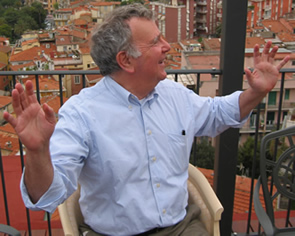Day 3: Nettuno-Benevento
The cemetery is small compared to the American cemetery in Nettuno and the rows of tombstones have beautiful plantings. The gravestones include more information about the person buried–including his age and, in most cases, a quotation from a poem or a short message from the family, as well as the carved regimental insignia and crosses. For whatever reason, the emotional wallop is intensified and it is impossible not to be moved while walking through the rows of headstones.






We spend a few minutes in the Archaelogical Museum also housed in the Villa Adele. Since there were many villas from Roman times in the Anzio area, they have recovered a lot of treasure from these houses. The highlight of the collection is an intricate mosaic fountain from the garden of one of the local villas. We make one last stop in Anzio…at an “alimentari” to pick up sandwiches for lunch.
As we are leaving to get on the road to Molise, we get a phone call from Giovanni, one of the organizers of the olive oil weekend in Molise, telling us that the other organizer’s mother has died and the event has been called off. So we take our lunch to a bench on a boardwalk overlooking the water and discuss where we should go for the next three days.
We decide to go to Benevento, a provincial town in Campania about an hour east of Naples. The town has a lot of Roman history and is the ancestral home of many Italian-Americans. We suspect that we will also find a lot of mozzarella di bufala there.
En route, we make a brief stop in Latina, a provincial city that was built under Mussolini in the 1930s and is known as an attractive, planned modern city. The city has broad boulevards and tree lined streets and seems more open and spread out than most Italian cities. We drive around for about 15 minutes–just to get a feel for it–and then continue on to Benevento.
Arriving at Benevento around 5 pm, we find the Gran Hotel Italiano quite easily since we are using our two GPS systems. During the day, we have figured out how to work the built-in GPS in the Peugeot so we have double GPS capability. We even figure out how to insert a SIM card and use our phone through the car’s audio system…..very high- tech.
The hotel is an older building on the main tree-lined boulevard that leads from the train station to the historic center. The desk clerk takes a liking to us–he always is looking for a chance to practice his English–and when I give him my Zurer Travel business card, he and the hotel manager upgrade us to a suite. He introduces us to his manager–Sgr. Italiano, who gives us a nice picture book about Benevento and the surrounding area. He tells us that he hopes that we can send more tourists to Benevento in the future. The desk clerk even asks us to look over the English translation of the dinner menu and we make several corrections (which are changed on the menu by dinner time.)
Once we unpack and get settled, we set out for the “centro storico” which is about a half mile from the hotel. The main street of Benevento’s “centro” is a broad pedestrian-only street–the Corso Garibaldi–with the Duomo and the main business district at the bottom and the government center and the Church of Santa Sofia at the top. We stroll up the avenue passing some of the historic landmarks as we walk……an Egyptian obelisk (in Roman times, Benevento was quite taken with the Egyptian goddess Isis)




The arch stands at the spot where the Appian Way passed through Benevento en route from Rome to Brindisi.
We walk back to the hotel as dusk falls and decide to eat dinner in the hotel restaurant rather then head out again in the evening. The fixed price menu looked very appealing as well as economical (Euro 18.50 for a full course meal).
Dinner turns out to be quite good….a nice antipasto table with ham, cheese, vegetables, etc. My lentil soup is one of the best lentil soups I have ever had–tasty, well-cooked and a huge portion–and Diana’s lasagna is very good. We share the second courses–a chicken cooked in a white wine sauce that is very tasty and a large portion of wonderful local mozzarella di bufala that we share. The wine is a crisp and light local white from Solopaca–a town about 10 km west– that we enjoy very much. The meal is finished with a very good fruit salad–macedonia. We say goodnight to the manager and his wife who are also eating dinner in the dining room.
A very enjoyable meal–the service was also very friendly and solicitous–and all we need to do after we eat is get into the elevator and go to our room. Tomorrow we explore more of Benevento.


0 Comments:
Post a Comment
<< Home